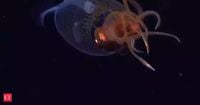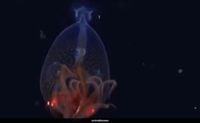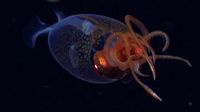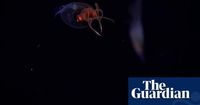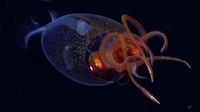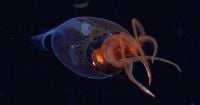In a remarkable deep-sea discovery, marine scientists have captured the first confirmed footage of a colossal squid swimming freely in its natural habitat, nearly a century after the species was first identified. This groundbreaking moment unfolded on March 9, 2025, near the South Sandwich Islands in the South Atlantic Ocean, as researchers aboard the Schmidt Ocean Institute's research vessel, Falkor (too), deployed a remotely operated vehicle named SuBastian.
The footage reveals a juvenile squid, scientifically named Mesonychoteuthis hamiltoni, measuring approximately 30 centimeters (11.8 inches) long, gliding through the dark depths at a staggering 600 meters (1,968 feet). This sighting marks a significant milestone, as it is the first time a colossal squid has been filmed alive in its natural environment since it was formally identified in 1925.
Dr. Kat Bolstad, an expert from Auckland University of Technology who assisted in verifying the species, expressed her excitement: "It’s exciting to see the first in situ footage of a juvenile colossal and humbling to think that they have no idea that humans exist." Until now, most knowledge about colossal squids has come from carcasses found in the stomachs of whales or as dying specimens pulled up by fishing vessels.
Colossal squids are known to be the heaviest invertebrates on Earth, capable of growing up to 7 meters (23 feet) and weighing as much as 500 kilograms (1,100 pounds). However, very little is known about their life cycle and behaviors, making this footage a crucial addition to marine biology.
The expedition, led by Dr. Michelle Taylor of the University of Essex, aimed to document life in one of the least explored corners of the deep sea. The team’s efforts not only captured the colossal squid but also recorded footage of another elusive deep-sea dweller, the glacial glass squid, during a previous Falkor (too) expedition in January 2025. Dr. Jyotika Virmani, executive director of the Schmidt Ocean Institute, noted, "The first sighting of two different squids on back-to-back expeditions is remarkable and shows how little we have seen of the magnificent inhabitants of the southern ocean."
During this historic expedition, the juvenile colossal squid displayed some of its defining features. Dr. Aaron Evans, an independent researcher who helped verify the species, described the squid as having lost some of its juvenile characteristics, such as stalked eyes that protrude from the head. Instead, its eyes are now more proportionate to its body, indicating a transition toward adulthood. Evans remarked, "We could think of this maybe as a teenager squid... It’s still got a lot of growing to do."
The presence of sharp, rotating hooks on the squid's arms, a unique adaptation for ambush predation, distinguishes the colossal squid from other cephalopods. This feature was particularly exciting for Bolstad, who stated, "One of the things I love about this footage is how delicate this animal appears to be. It looks like a glass sculpture." The squid's ability to switch between transparency and opacity is facilitated by large chromatophores, which can change color, adding to its mysterious allure.
Despite the excitement surrounding this discovery, much about the colossal squid remains enigmatic. The species is believed to inhabit the cold, dark depths of the Southern Ocean, where it can avoid detection from both predators and researchers alike. Evans explained, "The adult colossal squid remains mysterious and enigmatic because it has these senses, which allow it to see us. The colossal squid is limited to Antarctica, where we don’t get the opportunity to research quite as frequently."
As the Falkor (too) continues its research, the team hopes to capture more footage of these elusive creatures. The vessel will not return to Antarctica until 2028 but will operate in the South Atlantic Ocean off the coasts of Argentina and Uruguay over the next four years. Virmani emphasized the importance of sharing these discoveries in real-time, stating, "Now that we have the ability to share (dives) in real time in this way... our ability to appreciate the deep sea on a much wider scale is moving towards where it should have been all along."
This extraordinary footage not only sheds light on the life of the colossal squid but also serves as a reminder of the vast mysteries that remain hidden beneath the ocean's surface. As scientists continue to explore these depths, they are uncovering new insights into the behaviors and habitats of some of the planet's most enigmatic creatures.
The recent findings have sparked excitement among marine biologists and ocean enthusiasts alike, offering a rare glimpse into the hidden world of the Southern Ocean's deep-sea inhabitants. Bolstad noted, "These unforgettable moments continue to remind us that the ocean is brimming with mysteries yet to be solved." With every dive, researchers hope to unlock more secrets of the deep, revealing the astonishing diversity of life that thrives in the ocean's depths.
